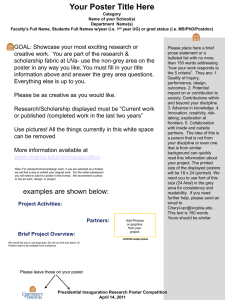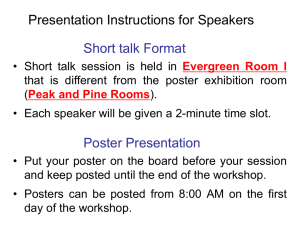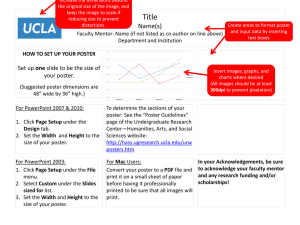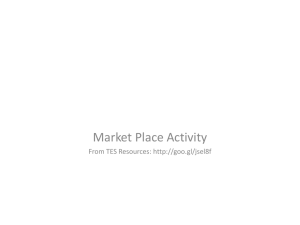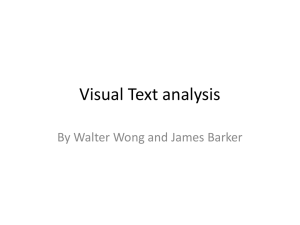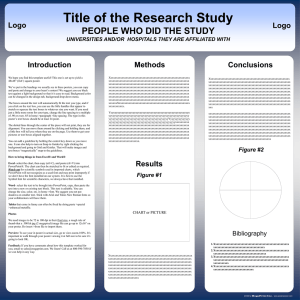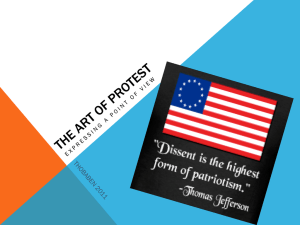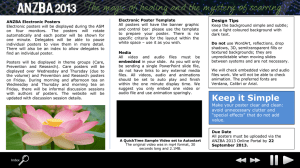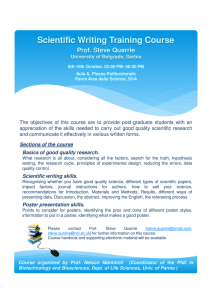Scientific Posters - The University of Texas at San Antonio
advertisement
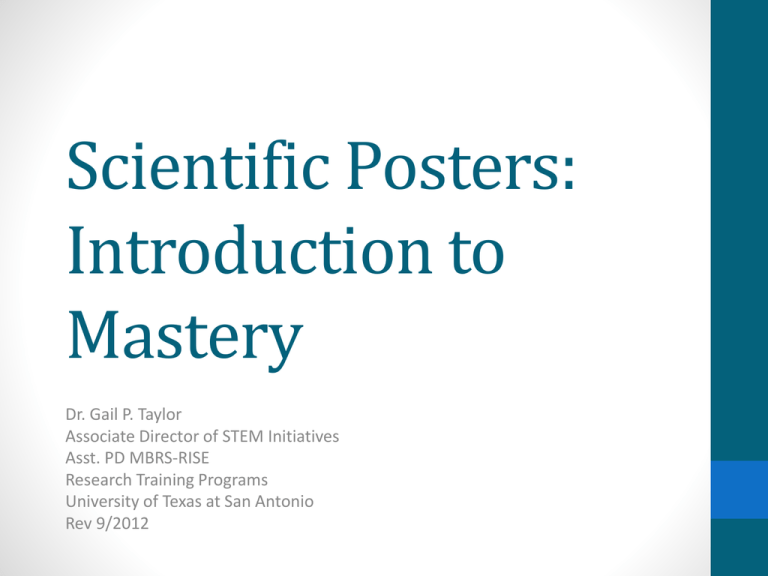
Scientific Posters: Introduction to Mastery Dr. Gail P. Taylor Associate Director of STEM Initiatives Asst. PD MBRS-RISE Research Training Programs University of Texas at San Antonio Rev 9/2012 Acknowledgements • ABRCMS poster Guidelines. http://www.abrcms.org/posterguidelines.asp • Colin Purrington: Advice for designing scientific posters. http://www.swarthmore.edu/NatSci/cpurrin1/posteradvice.htm • Knowledge Management in Health Services; HSERV 590A: Creating a Poster Using MS PowerPoint – University of Washington http://courses.washington.edu/~hs590a/weblinks/poster.html • Creating Effective Poster Presentations – Hess and Liegel. http://www4.ncsu.edu/~grhess/posters/ • University of Buffalo- Designing effective poster presentations http://ublib.buffalo.edu/libraries/units/sel/bio/posters.html • University of Kansas- Jeff Radel http://www.kumc.edu/SAH/OTEd/jradel/Poster_Presentations/PstrS tart.html Acknowledgements - Abstracts • Online How-To Presentation from SACNAS • http://www.vimeo.com/3968357 • How to construct a Nature summary paragraph • http://www.nature.com/nature/authors/gta/Letter_bold_para.doc The Scientific Poster Today: • The Poster • RUBRIC! • What to include • How it should look • How to make (Fast) • How to present Scientific Poster • • • • A form of Scientific Expression Summary of Research (5 – 10 minutes) Visually augmented discussion/interaction At conferences viewers come to you (or you can invite) • People search published abstracts • Posters may be grouped by field & folks may wander • New Information • Characteristic Fields • Appearance/Content varies by Field or Lab Where are Posters Used? • On Campus – Poster days, Conferences, symposia • Tack up poster • Stand by poster (1-3 h) • Conferences • • • • Abstract submitted Limited orals (15 min ea) Mostly Posters Time/location included in program • Hallways • Often posted around labs after presentation • Online: • http://posters.f1000.com/ • http://eposters.net/ Additional Poster Impact • Represents you and you mentor • Demonstrate expertise • Demonstrate attention to detail • • • • • • Practice public speaking Learn about most current results in field Deepens understanding of topic Opportunity for teaching and learning Share ideas Create collaborations PRIMARY GOAL • Sell Yourself and Your Research!! • Confident • Competent • Great Future Colleague • Need to Prepare! • Need to tell a good story! Poster History Which is a “Correct” Poster? Approaching Posters • • • • • Characteristic sections with expected information Consult rules of conference/rubrics Work in collaboration w research mentor Decide on experiments to include Create a storyboard/plan • • • • • Visually appealing Primarily image driven but stand alone Simply and tightly written Know what to say for each figure Transitions between sections • Practice for your audience • KNOW all details of project • Master questions Can be Personalized… Sections - Content • • • • • • • • • • • Title Names and Affiliations (sometimes extra email contacts) Abstract * (SAME AS SUBMITTED) Introduction Purpose/Hypothesis/Goal Methods Results Discussion/Conclusions/Future Directions References * Acknowledgements * *Can use smaller font Consult Rules of Conference • http://www.abrcms.org/index.php/abstractsposters/presentation-guidelines • Size Max (board size) vs Size Requirement • 36”x54” COS Research Conference • • • • • • Possible “sentence case” in titles Abstract number Abstract included or not Contact Information (extra?) Section headings (Abstract, Intro, etc) Font size Work with Mentor • Represents their laboratory • They need to be involved • New data available – what should be included? • Will want to make revisions (several times) • Need final approval EVERY submission • You should also arrange to practice w lab! Find RUBRIC if possible • • • • Published expectations Usually with student competitions Assists Judges to judge fairly http://www.abrcms.org/documents/11_Judging_Rubric.pdf • Emphasis on 6 areas: • • • • • • Posterboard or Powerpoint Hypothesis/Purpose and statement of problem (INTRO) Methods and controls/comparison (METHODS) Results (RESULTS) Conclusion and future work (DISCUSSION) Overall Presentation and handling questions Who is Your Audience? • Researchers in your field • Will read even if bad • Researchers in related fields • Easily persuaded to view • Previously uninterested passers by • Can be attracted by a good poster • ***You want to attract these people!*** • Perhaps Freshmen? • Don’t vary content, vary explanation Your Poster’s Appearance • Make rough plan of your poster • Will have “standard” headings • Poster provides visual aids as you talk • Picture worth 1K words • Carry information with colorful images and figures • Estimate space that will be needed – • • • • • How many experiments reported How many figures needed? What types of figures? How much text to explain 3 or 4 Column Poster • Space for text • Poster must be “stand alone” (understandable in halls, unmanned) • Has to have words • Word amount varies with field • Balance your text and images Appearance 2 • Select (or design) figures/bullets. • • • • • Where do you need help explaining something? (napkin?) Intro - Can have image of existing model, or eye catching photo Methods - can be a flow chart Results – Figures, Line Graphs common. Discussion – Often bulleted • Select number of columns • Average 4 (range 3-5) • 36”x54” good for 4 column (have results) • 36”x48” good for 3 column (Proposal or one experiment). • >42” tall is quite big- can be used if not enough room. Appearance 3 • Should be Visually Appealing • Understand reader “gravity” • Top left to bottom • Left to right • Have an obvious flow • Headings • Numbers • Use “white space” or color frames to organize • Unobtrusive/Neutral backgrounds • White • Lt grey • Lt beige Appearance 4 • Use very large font for title (~90 pt) • Fairly large for names (~72 pt) • Use at least 20 (24 better) pt text for body text • Read ~4/5 feet away • Figure lettering must also be large enough Visually Appealing Title • SAME AS ABSTRACT Names and Affiliations • • • • • • Names/Authorship (always more than you as student) Department, University, Centers, etc Address of Univ. (option) Email Address (may be required) Logos for Universities, Depts, Centers Use superscripts to match person to place More on Logos • Large or High Resolution • not Jaggy when print! • Near 300 DPI • > 1 MB • ~6 Inches Abstract • Most people insert entire abstract in upper first column • Can reduce font size if needed • Does NOT replace the normal Introduction • Unless your mentor says so. Simply and Tightly Written • Use figure legends/captions as text (not additional narrative) • Assess every sentence and word • Avoid long sentences and paragraphs • Combine very short sentences • Put related text and images near one another • Typos reflect badly on you and your mentor • There is no good writing, only good rewriting Introduction • • • • • • Or Background YOU SAY IT… If you are there, they won’t read! Get viewers interested This is separate from your abstract! Reason you chose to study • Foundation for your work (Models) • General topics to specific • • • • Equivalent to 1 double spaced 12 pt page Usually contain citations/references (cite!) May have Purpose and Hypothesis embedded Generally completes first column Purpose & Hypothesis • Sometimes a separate section, to emphasize • Purpose or…Objective, Aim, Goal, etc., • • • • Why you did experiment The purpose of this project… Good for Student Conference (Promotes solid judging) • Hypothesis • Same as for abstract RUBRIC: HYPOTHESIS AND/OR STATEMENT OF PROBLEM • For Maximal Impact/Points: • A logical hypothesis/statement of problem was presented clearly • Background information was relevant and summarized well. Connections to previous literature and broader issues were clear • Goal of project was stated clearly and concisely; showed clear relevance beyond project Materials/Methods • • • • Text with subheadings Can include a flow chart to summarize May include citations Make sure to include: • • • • • subjects experimental design drugs and equipment used statistical methods Why you chose the method RUBRIC! METHODS AND CONTROLS/COMPARISON • Maximize Impact/Points! • Clear discussion of controls or comparative groups; all appropriate controls or comparative groups were included • Thorough explanation of why particular methods were chosen Results • • • • • • • Largest section Vary with field Often two middle columns Experiments- what you found Don’t present raw data Make Image-based; use few words Maximize use of Figures • • • • • Make them simple Must be easily seen Make all lines wide enough All text large enough! Consistent axes across poster Results Cont: • Minimize use of tables • Difficult to grasp quickly • Use figure legends/captions as text • Put text near figure it’s describing • ~1 paragraph per image/image group RUBRIC! RESULTS • Maximal Impact/Points from: • Substantial amounts of high quality data were presented sufficient to address the hypothesis • Presentation of data was clear, thorough, and logical Conclusions/Discussion • • • • Or discussion or summary Very few words Bullets good Bigger font if needed • • • • *Summarize “take home” results *How did hypothesis work out? *Tie back to real world problem *Why Important/Implications RUBRIC! CONCLUSION AND FUTURE WORK • Highest Impact/Score if: • Reasonable conclusions were given and strongly supported with evidence • Conclusions were compared to hypothesis and their relevance in a wider context was discussed References • If someone’s work is cited (usually in introduction), you must include a reference • Generally “short” (title optional) • Can use smaller font if needed Acknowledgements • Should be included • Thank people • Mentor • Lab Mates • Technical assistance, etc. • Reveal possible conflicts of interest • Identify funding utilized • Ex. NIH/NIGMS MARC U*STAR GM007717 • Font can be smaller than rest of text RUBRIC! POSTER BOARD OR POWERPOINT PRESENTATION • Highest possible Impact/score when: • All expected components are present, clearly laid out, and easy to follow in the absence of presenter • The text is concise, legible, and consistently free of spelling or typographical errors; the background is unobtrusive • The figures and tables are appropriate and consistently labeled correctly • Photographs/tables/graphs improve understanding and enhance the visual appeal Creating the Poster Software • Actual layout: • • • • • • • • Powerpoint (one big slide) Pagemaker Canvas Illustrator Quark Postergenius: http://www.postergenius.com/cms/index.php Ask print shop about requirements Print directly or convert to pdf • Images (compatible with printer driver!) • Photoshop • MS Photo editor • Tables/Graphs • Directly from Office (Excel or Word) • For PRINTING: PowerPoint or full sized PDF. PowerPoint • Has 56” maximum dimension • Create at full size (or nearly so) to prevent pixelation • Set page size to desired size Pictures • Use standard formats • .jpg, .gif, .tiff, .tif, .bmp • Watch resolution of photos • 72 dpi vs 300 • • • • • 72 dpi will look pixelated on a poster 230 dpi prints like a photo Insert high dpi photos Make them relatively large Stretch to correct size Enlarging Images/Tables/Figures • To enlarge proportionally: • Click on image • Put cursor on corner • Left click and slide diagonally Additional Info • Insert individual text boxes • Text • Labeling • Right click on images for sizing, formatting and arranging • Right click on Text Boxes for manipulation • TEXT BOX can be manipulated! • This is how you do it! • Woooo! Additional Info • Turn green dots for rotation • Drawing tools can order objects • Drawing tools can align objects • Great for sizing and location on poster! Leave time for Critiques • Your mentor will inevitably change your poster…. • Have friends read as well… • Pimp My Poster: http://www.flickr.com/groups/ 688685@N24/ PHOTO BY COLIN PURRINGTON http://www.swarthmore.edu/NatSci/cpurrin1/posteradvice.htm Look at Sample Posters and Critique… Analyze Mechanics of Presentation Remember the Selling Yourself Thing… • Look good! Practicing • • • • • • • Finish early enough to practice MAKE SURE TO PRACTICE! Develop 5 minute presentation Know first sentence What to say for each figure (3 pts…) Transitions between figures What to point at for each figure First Contact • • • • • • • • • • Stand to left of poster (where start reading) Take initiative Smile, but stay near poster If they come closer Say, “Hello” and shake hands Give name. Get their name. Give level, and school (if you are not at UTSA) Ask if they’d like “you to walk them through your poster” YES? Then GO! This is work that I performed this summer in the ___ program in the laboratory of Dr. _________ at UT San Antonio. • (Optional) Ask if they are familiar with this field of research • No- More introduction, careful with acronyms • Yes- Can go more quickly through intro Flow • Start with Intro that will catch them • No pointing if you have no figure! • Move to Methods • Briefly summarize • Move to Results • Longest section • Indicate at beginning if did not work • Walk thru all figures • • • • Transition to Conclusions Say Conclusions Acknowledgements (optional) Any Questions? Practice • • • • • • • • • Practice with labmates and laymen Run through ENTIRE poster Be friendly Don’t sound like you’ve memorized Be excited about your work Remember to refer to your poster! They may interrupt with questions Pause long enough for them look at figure Know what questions may be asked…. • Can practice them RUBRIC! OVERALL PRESENTATION & HANDLING QUESTIONS • Highest Possible Impact/Score when: • Demonstrates a very strong knowledge of the research project • Speaks clearly, naturally and with enthusiasm; makes eye contact • Comfortably uses visual aids to enhance presentation • Answers difficult questions clearly and succinctly • Presentation is consistently clear and logical Transporting Poster • Buy tube for rolling • Do not be separated from it • Plane • Hotel • Carry it yourself • Have it also in electronic format • Do not leave it at home or in car trunk Supplemental Materials • • • • • • Mini-poster printed out Poster repair kit Pins Business cards Water Notebook Set up conditions vary • May be hard to hear • Must speak up!!! PHOTOS BY COLIN PURRINGTON http://www.swarthmore.edu/NatSci/cpurrin1/posteradvice.htm Final Preparations • Dress for situation • Follow culture of conference • Student conference – suit…or minimally khaki's • Comfortable shoes • • • • Be there on time! Have friend there to help Water bottle Don’t leave unless it is very important to do so (if so, leave a friend there momentarily) Extras • • • • Networking – write down ideas and names! Don’t be discouraged if only a few come! Can provide a mini version of poster Have a business card for professional meetings • May tack envelop, with picture of card, to poster Coming Home Again • Keep promises that you’ve made • Drop emails to folks whom you’ve met • Hang poster outside of lab • Can Deposit your Poster if desires (or allowed by mentor) • http://posters.f1000.com/ Poster Templates… • Sample posters can be seen online • google search • A “template” can be found at: • http://www.utsa.edu/mbrs/resources.htm Thanks for Coming… Good Luck with your posters!
